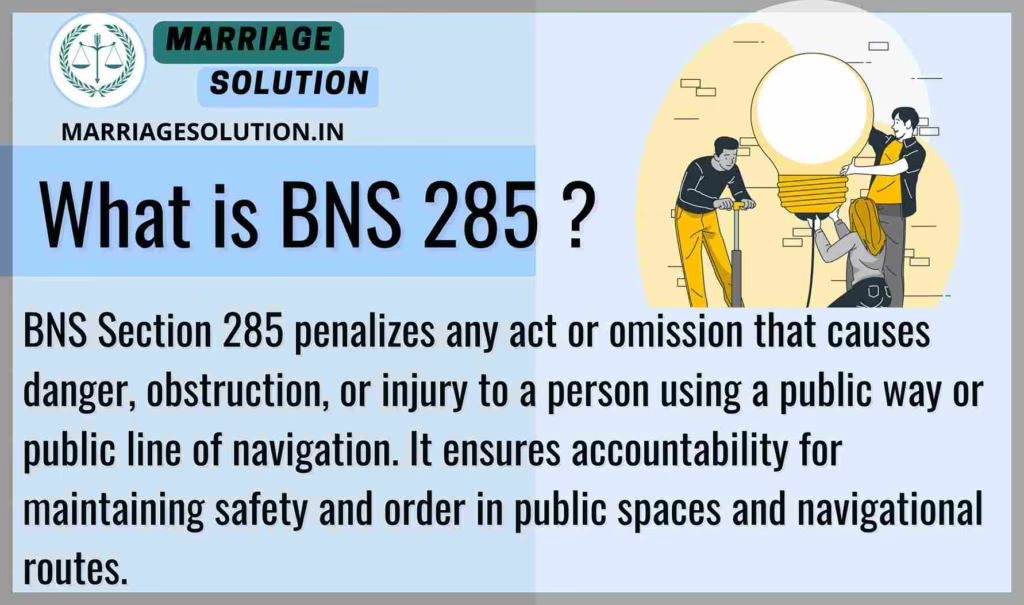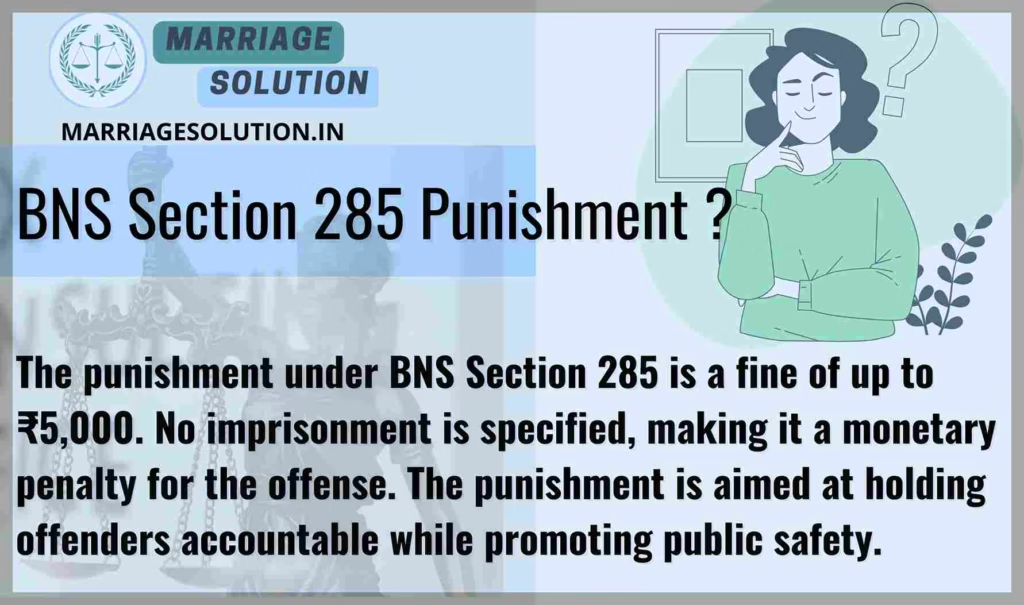Introduction of 285 BNS
285 BNS is designed to safeguard the safety and accessibility of public roads and waterways. It penalizes any act or omission that creates danger, obstruction, or injury for people using public paths or navigation routes. The provision holds individuals and organizations accountable for negligence or deliberate actions that disrupt public safety, thereby ensuring smoother transportation and preventing accidents.
The Bharatiya Nyaya Sanhita (BNS) Section 285 replaces the old Indian Penal Code (IPC) Section 283.
What is BNS Section 285 ?
BNS Section 285 penalizes any act or omission that causes danger, obstruction, or injury to a person using a public way or public line of navigation. It ensures accountability for maintaining safety and order in public spaces and navigational routes.

Under Section 285 of the bns act 2023
Whoever, by any act or omission, causes danger, obstruction, or injury to any person in any public way or public line of navigation, shall be punished with fine which may extend to five thousand rupees.
1. Meaning of the Provision
- The law covers both acts and omissions that create hazards in public areas.
- “Public way” includes roads, streets, and footpaths accessible to the public.
- “Line of navigation” refers to rivers, canals, or other waterways used by boats or ferries.
2. Scope of the Law
- Applies to any person who through negligence or deliberate action causes obstruction or danger.
- Includes property owners, businesses, construction operators, or individuals using public spaces.
3. Essential Ingredients
To establish liability under BNS Section 285, it must be proven that:
- The accused committed an act or omission.
- The act caused danger, obstruction, or injury.
- It occurred on a public way or line of navigation.
4. Examples
- Leaving construction debris on a road that causes accidents.
- Carelessly anchoring a boat in a busy waterway, blocking navigation.
- Dumping hazardous materials on a footpath.
5. Punishment under BNS Section 285
- Fine: Up to ₹5,000.
- No imprisonment prescribed.
- Focuses on correction and deterrence, not punishment alone.
6. Legal Classification
- Bailable – accused can get bail.
- Cognizable – police can act without prior approval.
- Non-compoundable – cannot be settled privately.
- Triable by any Magistrate – allows quick disposal.
Section 285 BNS Overview
BNS Section 285 deals with acts or negligence that cause danger, obstruction, or injury to individuals in public ways or navigational routes. It ensures accountability for maintaining safety and accessibility in such public areas.
10 Key Points of BNS Section 285
1. Objective of the Section
The main purpose of BNS Section 285 is to keep public places safe and accessible for everyone. It deals with actions or failures that create danger or obstacles in public areas, roads, or waterways. This law ensures that people can use public spaces without fear, inconvenience, or harm. It also encourages citizens to behave responsibly when using or managing public spaces.
2. Applicability
This section applies to anyone whose action or negligence causes danger or obstruction on public roads, paths, or water routes. It includes both direct acts (like blocking a road with vehicles or objects) and failure to act (like not removing harmful debris or leaving unsafe materials unattended). If such behavior puts the public at risk, this law becomes applicable.
3. Nature of the Offense
The offense under this law is cognizable, which means police can take action, investigate, and file a case without needing permission from a Magistrate. This helps in quickly addressing situations that affect public safety and prevents delays in removing hazards or obstructions that impact daily life.
4. Non-Compoundable Nature
This offense is non-compoundable, meaning it cannot be settled privately between the parties involved. Since the issue affects the general public and not just one person, the law requires the case to go through the court. This ensures that public rights are protected through proper legal process.
5. Bailable Provision
Although it concerns public safety, the offense is bailable, which means the accused can get bail easily. This shows that the violation is not extremely serious. The main focus is on correction and ensuring the obstruction or danger is removed quickly rather than keeping the person in custody for long.
6. Role of Intent and Negligence
This section punishes both intentional and negligent behavior. Whether someone blocks a public path on purpose or carelessly leaves things that cause danger, both are treated as offenses. This ensures that people cannot escape responsibility by claiming it was “not done on purpose.” The law promotes responsible conduct in public spaces.
7. Monetary Penalty
The punishment for violating this section is a fine of up to ₹5,000. There is no jail term, which shows that the law aims to correct behavior rather than punish harshly. The fine acts as a warning so that people think twice before causing trouble or creating unsafe conditions in public places.
8. Impact on Public Safety
By punishing those who cause dangers or block public areas, this law helps maintain safe, smooth, and disturbance-free public movement. It reduces the chances of accidents, traffic delays, public discomfort, and inconvenience. Overall, it improves daily life and supports public safety and order.
9. Responsibility of Property Owners
People who own or manage property near public roads or areas must ensure their property does not create risk or obstruction. For example, they must repair broken walls, remove loose construction material, or stop water leakage onto roads. This promotes responsible maintenance and prevents harm to the public.
10. Judicial Oversight
Cases under Section 285 can be handled by any Magistrate, making the legal process faster and more flexible. This helps the court address such issues without delay, ensuring quick action to restore public safety and convenience.
2 Examples of BNS Section 285
- Example 1: Debris on a Public Road
A construction company leaves debris and sharp objects on a busy road, creating a hazard for vehicles and pedestrians. This negligence leads to an accident. The company can be held accountable under BNS Section 285 for causing danger and obstruction in a public way. - Example 2: Blocking a Navigational Channel
A fisherman anchors his boat carelessly in the middle of a busy waterway, obstructing other boats and endangering their movement. If an accident occurs or the obstruction hampers navigation, he can be penalized under BNS Section 285.
BNS 285 Punishment
The punishment under BNS Section 285 is a fine of up to ₹5,000. No imprisonment is specified, making it a monetary penalty for the offense. The punishment is aimed at holding offenders accountable while promoting public safety.

BNS 285 bailable or not ?
BNS Section 285 is a bailable offense, meaning the accused has the right to secure bail without significant legal hurdles. This reflects the less severe nature of the offense while still emphasizing accountability.
Comparison: BNS Section 285 vs IPC Section 283
| Section | What it Means | Punishment / Consequence | Bailable | Cognizable | Trial By |
|---|---|---|---|---|---|
| BNS Section 286 | Deals with rash or negligent handling of poisonous substances that endangers human life or causes injury. Includes both unsafe actions and failure to take preventive safety measures. | Imprisonment up to 6 months, or fine up to ₹5,000, or both. Penalties updated for stronger deterrence and public safety. | Bailable | Cognizable | Any Magistrate |
| IPC Section 284 (Old) | Punished negligent conduct with poisonous substances that could endanger life or cause harm. Focused mainly on negligence without clear mention of omissions. | Imprisonment up to 6 months, or fine up to ₹1,000, or both. Lower fine reduced the deterrence effect. | Bailable | Cognizable | Any Magistrate |
| Key Difference: BNS Section 286 replaces IPC Section 284 with an increased fine (₹5,000 vs ₹1,000) and clearer inclusion of omissions along with rash acts, ensuring stronger accountability and better protection against negligent handling of poisonous substances. | |||||
BNS Section 285 FAQs
What does BNS Section 285 cover?
BNS Section 285 penalizes acts or negligence that cause danger, obstruction, or injury to people using public ways or navigational routes. It ensures the safety and accessibility of these public spaces.
What is the punishment under BNS Section 285?
The punishment for violating BNS Section 285 is a fine that may extend up to ₹5,000. There is no imprisonment prescribed for this offense.
Is BNS Section 285 a bailable offense?
Yes, BNS Section 285 is a bailable offense, meaning the accused can secure bail without difficulty.
Is BNS Section 285 cognizable or non-cognizable?
It is a cognizable offense, allowing the police to register a case and begin investigation without prior approval from a Magistrate.
Who tries cases under BNS Section 285?
Cases under BNS Section 285 are triable by any Magistrate, ensuring flexibility in judicial proceedings.
What type of acts can be punished under BNS Section 285?
Any act or omission causing obstruction or danger in public spaces, such as leaving hazardous debris on a road or blocking a navigational route, falls under BNS Section 285.
Conclusion
BNS Section 285 plays a vital role in ensuring safe and obstruction-free public spaces and navigational routes. By penalizing both intentional acts and negligent omissions, the law promotes accountability and safeguards citizens’ right to safe access in roads and waterways. Unlike the outdated IPC provision, the updated penalty and cognizable nature of this section make it more effective in addressing modern public safety challenges. It acts as a preventive measure, encouraging individuals, businesses, and authorities to maintain responsibility in public areas and contribute to a safer community.
Need Legal Support?
If you are dealing with court cases, marriage problems, or any other legal issue, our team at Marriage Solution – Lawyer Help is here for you. Simply fill out our quick online enquiry form, and we’ll connect you with the right legal expert to support your needs.
Finished with BNS 285 ? Continue exploring the next provisions of the Bharatiya Nyaya Sanhita (BNS), 2023. Each section includes explanations, examples, and plain-language breakdowns for easy understanding.
- 286 BNS : Negligent conduct with respect to poisonous substance.
- https://marriagesolution.in/bns_section/286-bns/
- 287 BNS : Negligent conduct with respect to fire or combustible matter.
- https://marriagesolution.in/bns_section/287-bns/
- 288 BNS : Negligent conduct with respect to explosive substance.
- https://marriagesolution.in/bns_section/288-bns/
- 289 BNS : Negligent conduct with respect to machinery.
- https://marriagesolution.in/bns_section/289-bns/
- 290 BNS : Negligent conduct with respect to pulling down, repairing or constructing buildings etc.
- https://marriagesolution.in/bns_section/290-bns/
Full IPC Section List: https://marriagesolution.in/ipc-section-list
All Indian Law & Blogs: https://marriagesolution.in/indian-law/
Full BNSS Section List: https://marriagesolution.in/bnss_section-list
